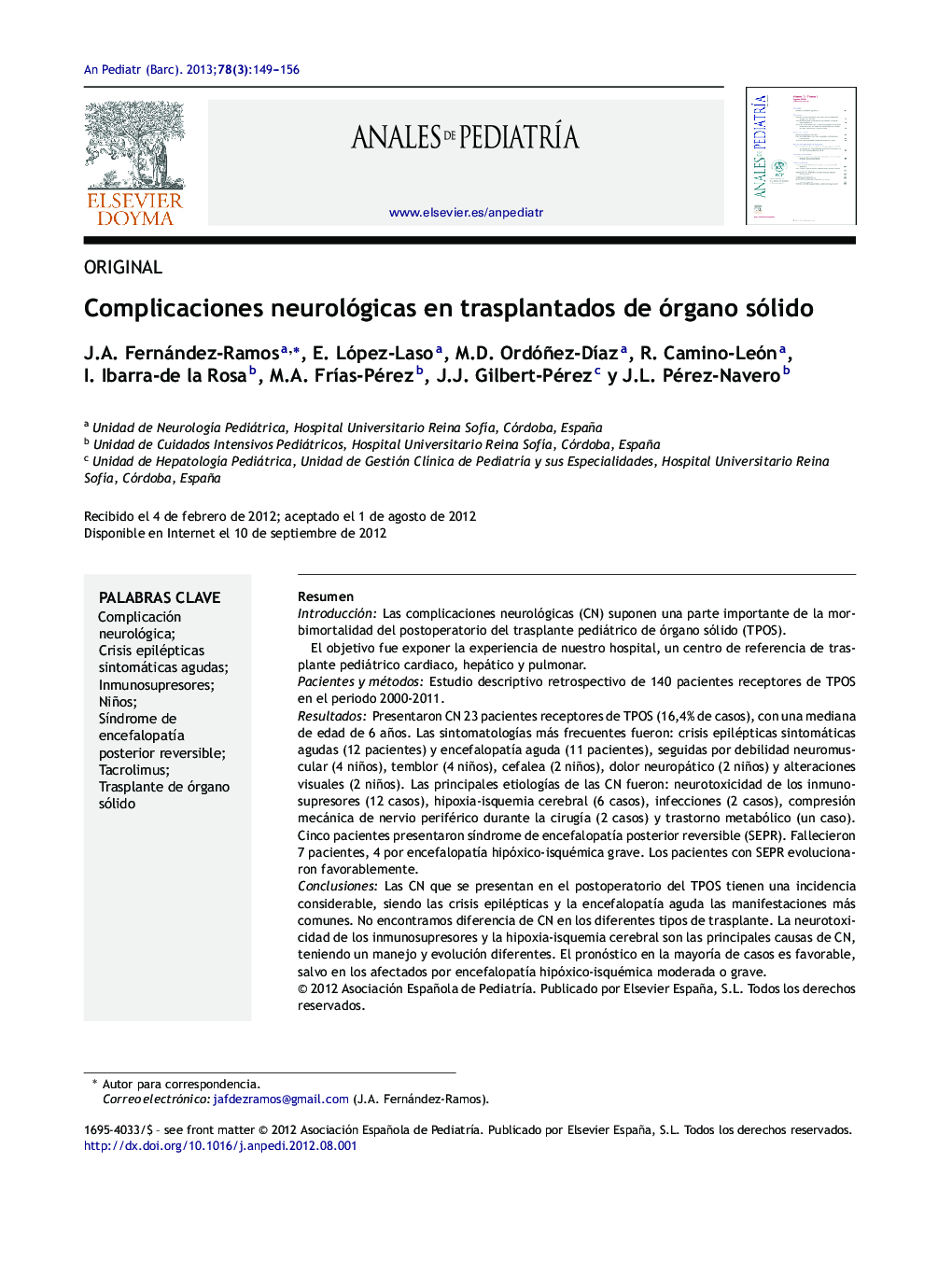| کد مقاله | کد نشریه | سال انتشار | مقاله انگلیسی | نسخه تمام متن |
|---|---|---|---|---|
| 4141808 | 1272344 | 2013 | 8 صفحه PDF | دانلود رایگان |

ResumenIntroducciónLas complicaciones neurológicas (CN) suponen una parte importante de la morbimortalidad del postoperatorio del trasplante pediátrico de órgano sólido (TPOS).El objetivo fue exponer la experiencia de nuestro hospital, un centro de referencia de trasplante pediátrico cardiaco, hepático y pulmonar.Pacientes y métodosEstudio descriptivo retrospectivo de 140 pacientes receptores de TPOS en el periodo 2000-2011.ResultadosPresentaron CN 23 pacientes receptores de TPOS (16,4% de casos), con una mediana de edad de 6 años. Las sintomatologías más frecuentes fueron: crisis epilépticas sintomáticas agudas (12 pacientes) y encefalopatía aguda (11 pacientes), seguidas por debilidad neuromuscular (4 niños), temblor (4 niños), cefalea (2 niños), dolor neuropático (2 niños) y alteraciones visuales (2 niños). Las principales etiologías de las CN fueron: neurotoxicidad de los inmunosupresores (12 casos), hipoxia-isquemia cerebral (6 casos), infecciones (2 casos), compresión mecánica de nervio periférico durante la cirugía (2 casos) y trastorno metabólico (un caso). Cinco pacientes presentaron síndrome de encefalopatía posterior reversible (SEPR). Fallecieron 7 pacientes, 4 por encefalopatía hipóxico-isquémica grave. Los pacientes con SEPR evolucionaron favorablemente.ConclusionesLas CN que se presentan en el postoperatorio del TPOS tienen una incidencia considerable, siendo las crisis epilépticas y la encefalopatía aguda las manifestaciones más comunes. No encontramos diferencia de CN en los diferentes tipos de trasplante. La neurotoxicidad de los inmunosupresores y la hipoxia-isquemia cerebral son las principales causas de CN, teniendo un manejo y evolución diferentes. El pronóstico en la mayoría de casos es favorable, salvo en los afectados por encefalopatía hipóxico-isquémica moderada o grave.
IntroductionNeurological complications (NC) are a significant cause of morbidity and mortality in paediatric patients receiving solid organ transplants. Our aim was to describe the experience of our hospital with NC in paediatric patients receiving heart, lung and liver transplants.Patients and methodsA retrospective study was conducted on 140 paediatric patients who received a solid organ transplant during the period 2000-2011.ResultsA total of 23 paediatric solid organ transplant recipients (16.4% of cases), with a median age of 6 years, had NC. The symptoms were, in order of frequency: acute symptomatic seizures (12 patients); acute encephalopathy (11 patients); neuromuscular weakness (4 children), tremor (4 children), headache (2 children), neuropathic pain (2 children), and visual disturbances (2 children). The aetiologies of NC were: the neurotoxicity of the immunosuppressive drugs (12 patients), post-hypoxic-ischaemic encephalopathy (6 patients), infections (2 cases), mechanical compression of peripheral nerve during surgery (2 cases), and a metabolic complication (1 case). The five patients who met the criteria of posterior reversible encephalopathy syndrome had a favourable outcome. Seven patients died, four of them due to hypoxic-ischaemic encephalopathy.ConclusionsNC are common in paediatric patients receiving heart, liver, lung, and renal transplants, with acute symptomatic seizures and acute encephalopathy being the most common clinical signs. No differences were found in the NC with the different types of transplants. Neurotoxicity of the immunosuppressive drugs and hypoxic-ischaemic encephalopathy were the main causes of NC, having different management and outcomes. The prognosis was favourable in most of the patients, except for those who had moderate or severe post-hypoxic-ischaemic damage.
Journal: Anales de Pediatría - Volume 78, Issue 3, March 2013, Pages 149–156